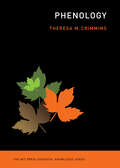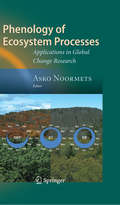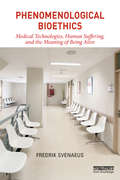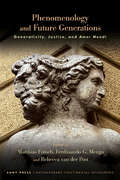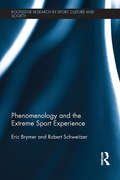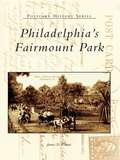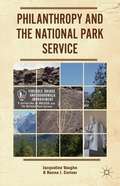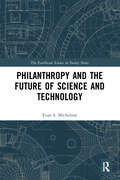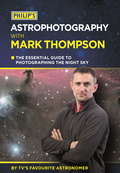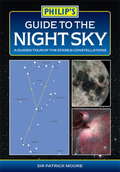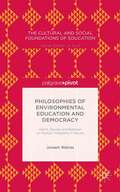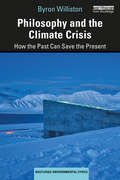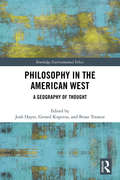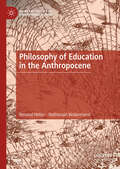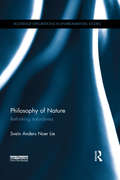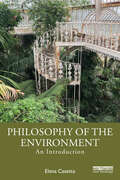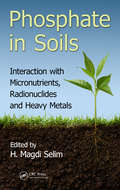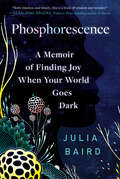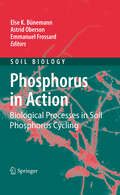- Table View
- List View
Phenological Synchrony and Bird Migration: Changing Climate and Seasonal Resources in North America (Studies in Avian Biology)
by Eric M. Wood Jherime L. KellermannBird migration is a well-researched phenological event. However, few studies in North America have investigated the effects of climate change and extreme weather on the relationships of migratory avian species and their seasonal resources. This is a critical gap in knowledge that limits our ability to prioritize management and conservation applicat
Phenology (The MIT Press Essential Knowledge series)
by Theresa M. CrimminsOn the timing of seasonal activity in plants and animals, the impact of climate change, and what each of us, as everyday phenologists, can do to help.Phenology is all about timing—when trees leaf out, flowers bloom, birds migrate, animals bear young and hibernate—and it is everywhere around us. This handy companionable volume shows how we are all phenologists in our own way, and how the everyday science can help us make sense of the changing seasons and our changing world. Explaining how the phenomenon of phenology is threaded through our daily lives, Theresa Crimmins points to events that occur on an annual basis in plants’ and animals’ lives in response to fluctuations in daylength, temperatures, and rainfall patterns. She also covers less visible seasonal events, such as when roots typically begin to grow or when mushrooms release their spores. On a more urgent note, Phenology describes how this seasonal activity is being affected by rapidly changing climate conditions—and why this matters. Consequently, the book invites readers to participate in documenting the timing of seasonal life cycle events—for the practice’s real benefits to mental health, but also for the good of the environment, as the data gathered can be directly helpful in supporting climate change action.
Phenology of Ecosystem Processes
by Asko NoormetsTerrestrial carbon balance is uncertain at the regional and global scale. A significant source of variability in mid-latitude ecosystems is related to the timing and duration of phenological phases. Spring phenology, in particular, has disproportionate effects on the annual carbon balance. However, the traditional phenological indices that are based on leaf-out and flowering times of select indicator species are not universally amenable for predicting the temporal dynamics of ecosystem carbon and water exchange. Phenology of Ecosystem Processes evaluates current applications of traditional phenology in carbon and H2O cycle research, as well as the potential to identify phenological signals in ecosystem processes themselves. The book summarizes recent progress in the understanding of the seasonal dynamics of ecosystem carbon and H2O fluxes, the novel use of various methods (stable isotopes, time-series, forward and inverse modeling), and the implications for remote sensing and global carbon cycle modeling. Each chapter includes a literature review, in order to present the state-of-the-science in the field and enhance the book's usability as an educational aid, as well as a case study to exemplify the use and applicability of various methods. Chapters that apply a specific methodology summarize the successes and challenges of particular methods for quantifying the seasonal changes in ecosystem carbon, water and energy fluxes. The book will benefit global change researchers, modelers, and advanced students.
Phenomenological Bioethics: Medical Technologies, Human Suffering, and the Meaning of Being Alive
by Fredrik SvenaeusEmerging medical technologies are changing our views on human nature and what it means to be alive, healthy, and leading a good life. Reproductive technologies, genetic diagnosis, organ transplantation, and psychopharmacological drugs all raise existential questions that need to be tackled by way of philosophical analysis. Yet questions regarding the meaning of life have been strangely absent from medical ethics so far. This book brings phenomenology, the main player in the continental tradition of philosophy, to bioethics, and it does so in a comprehensive and clear manner. Starting out by analysing illness as an embodied, contextualized, and narrated experience, the book addresses the role of empathy, dialogue, and interpretation in the encounter between health-care professional and patient. Medical science and emerging technologies are then brought to scrutiny as endeavours that bring enormous possibilities in relieving human suffering but also great risks in transforming our fundamental life views. How are we to understand and deal with attempts to change the predicaments of coming to life and the possibilities of becoming better than well or even, eventually, surviving death? This is the first book to bring the phenomenological tradition, including philosophers such as Martin Heidegger, Edith Stein, Maurice Merleau-Ponty, Jean-Paul Sartre, Hans-Georg Gadamer, Paul Ricoeur, Hans Jonas, and Charles Taylor, to answer such burning questions.
Phenomenology and Future Generations: Generativity, Justice, and Amor Mundi (SUNY series in Contemporary Continental Philosophy)
by Matthias Fritsch, Ferdinando G. Menga and Rebecca van der PostIn the face of widespread environmental and social destabilization and growing uncertainty about the future of humanity, this collection of essays brings the philosophical tradition of phenomenology to the question of relations between generations to examine our ethical, political, and environmental obligations to future people. Emphasizing phenomenology's rich reflections on the role of time in the constitution of the social-historical world and its relation to the environment, the essays interweave the central themes of mortality, natality, generativity, and amor mundi to build vital bridges between new developments in both eco- and critical phenomenology and important work in intergenerational ethics. Together, the chapters reevaluate the traditional scope and foundational concepts of environmental ethics and social justice, paving the way for a revised understanding of intergenerational responsibilities, culminating in the key insight that future people are of us. The result is an invaluable conceptual toolkit for phenomenologists, ethicists, theorists, students, and activists concerned with environmental justice and climate ethics.
Phenomenology and the Extreme Sport Experience (Routledge Research in Sport, Culture and Society)
by Eric Brymer Robert SchweitzerUnderstanding the motivations behind those who partake in extreme sports can be difficult for some. If the popular conception holds that the incentive behind extreme sports participation is entirely to do with risking one’s life, then this confusion will continue to exist. However, an in-depth examination of the phenomenology of the extreme sport experience yields a much more complex picture. This book revisits the definition of extreme sports as those activities where a mismanaged mistake or accident would most likely result in death. Extreme sports are not necessarily synonymous with risk and participation may not be about risk-taking. Participants report deep inner transformations that influence world views and meaningfulness, feelings of coming home and authentic integration as well as a freedom beyond the everyday. Phenomenologically, these experiences have been interpreted as transcendent of time, other, space and body. Extreme sport participation therefore points to a more potent, life-enhancing endeavour worthy of further investigation. This book adopts a broad hermeneutic phenomenological approach to critique the assumed relationship to risk-taking, the death wish and the concept of "No Fear" in extreme sports, and repositions the experience in a previously unexplored manner. This is valuable reading for students and academics interested in Sports Psychology, Social Psychology, Health Psychology, Tourism, Leisure Studies and the practical applications of phenomenology.
Philadelphia's Fairmount Park
by James D. RistinePhiladelphia's Fairmount Park focuses on the more than four thousand acres of land along the east and west banks of the Schuylkill River and into parts of the Wissahickon Valley that comprise one of the world's largest urban parks. Historically and architecturally important structures and buildings are chronicled, such as the famous waterworks, the many bridges that span the park's waterways, the Zoological Gardens, and Boathouse Row. Numerous fountains, monuments, and artistic sculptures that dot the landscape are also documented. Rich in natural beauty, the park's meadows, gardens, lush vegetation, rugged ravines, and wooded areas will capture the eye. Philadelphia's Fairmount Park is a nostalgic view of the park as it was enjoyed by visitors during the first quarter of the twentieth century.
Philanthropy And The National Park Service
by Jacqueline Vaughn Hanna J. CortnerAs the National Park Service prepares for its centennial in 2016, this book provides an in-depth analysis of the role of philanthropy in national parks, with a focus on non-profit organizations known as friends groups and cooperating associations. Providing a historical review of partnerships through the lifetime of the NPS, up to a contemporary analysis of the legal and organizational framework under which non-profit philanthropic partners operate, Jacqueline Vaughn and Hanna J. Cortner explore the challenges the National Park Service faces in dealing with non-profit partners. Based on personal interviews with more than 50 non-profit leaders and National Park Service staff, financial data, and comprehensive site visits, Vaughn and Cortner offer a unique and informative view of the landscape in which philanthropy groups succeed - and sometimes fail.
Philanthropy and the Future of Science and Technology (The Earthscan Science in Society Series)
by Evan S. MichelsonAn increasingly important and often overlooked issue in science and technology policy is recognizing the role that philanthropies play in setting the direction of research. In an era where public and private resources for science are strained, the practices that foundations adopt to advance basic and applied research needs to be better understood. This first-of-its-kind study provides a detailed assessment of the current state of science philanthropy. This examination is particularly timely, given that science philanthropies will have an increasingly important and outsized role to play in advancing responsible innovation and in shaping how research is conducted. Philanthropy and the Future of Science and Technology surveys the landscape of contemporary philanthropic involvement in science and technology by combining theoretical insights drawn from the responsible research and innovation (RRI) framework with empirical analysis investigating an array of detailed examples and case studies. Insights from interviews conducted with foundation representatives, scholars, and practitioners from a variety of sectors add real-world perspective. A wide range of philanthropic interventions are explored, focusing on support for individuals, institutions, and networks, with attention paid to the role that science philanthropies play in helping to establish and coordinate multi-sectoral funding partnerships. Novel approaches to science philanthropy are also considered, including the emergence of crowdfunding and the development of new institutional mechanisms to advance scientific research. The discussion concludes with an imaginative look into the future, outlining a series of lessons learned that can guide how new and established science philanthropies operate and envisioning alternative scenarios for the future that can inform how science philanthropy progresses over the coming decades. This book offers a major contribution to the advancement of philanthropic investment in science and technology. Thus, it will be of considerable interest to researchers and students in public policy, public administration, political science, science and technology studies, sociology of science, and related disciplines.
Philip's Astrophotography With Mark Thompson: The Essential Guide To Photographing The Night Sky By TV's Favourite Astronomer
by Mark ThompsonPhilip's Astrophotography With Mark Thompson is an essential guide for anyone wishing to photograph or image the stars and planets, written by TV's favourite astronomer. For many people, looking at the sky is not enough and they would love to try and capture what they can see. Until a few years ago, capturing astronomical images was fraught with many challenges, but with the development of digital cameras replacing film, things have become much easier and great astronomical images are now within the reach of even the most novice stargazer. Mark Thompson has spent many years capturing the beauty of the night sky, first with film and now with the digital camera, and has discovered and overcome many of the pitfalls. This book takes the reader on a journey through the world of capturing astronomical images from using the humble mobile phone to specialist cameras, brought to life with Mark's personal experiences and many of his own astronomical images.
Philip's Guide to the Night Sky: A Guided Tour Of The Stars And Constellations (Philip's Astronomy Ser.)
by Sir Patrick MooreFind your way around the night sky with this handy guide to stargazing for the complete novice. In Philip's Guide to the Night Sky, Sir Patrick Moore explains how to find the most famous constellations and the brightest stars, and when to look for them. Clear star maps, showing stars visible to the naked eye, help you to navigate the skies. The maps are suitable for use in Britain, Ireland, northern Europe and Canada.Sir Patrick introduces the wonders of the night sky to absolute beginners in his characteristically entertaining and informative style. The Moon, the planets, the Sun and the stars are explained in non-technical language, while the constellations are described with the help of star maps and tables.The four main chapters in Philip's Guide to the Night Sky are devoted to what's on view in each season of the year. The information is appropriate for observers in Britain and Ireland, northern Europe and Canada; it will also be helpful a little outside these latitudes. Using prominent patterns, such as the Plough and Orion, Sir Patrick teaches the reader to 'star-hop' from constellation to constellation, thus learning to navigate the night sky. Star maps and photographs illustrate and clarify what will be on view. Philip's Guide to the Night Sky is an ideal introduction to stargazing, suitable for all ages and with no need for anything more technical than the naked eye.
Philip's Guide to the Night Sky: A guided tour of the stars and constellations (Philip's Guide to...)
by Sir Patrick MooreFind your way around the night sky with this handy guide to stargazing for the complete novice. In Philip's Guide to the Night Sky, Sir Patrick Moore explains how to find the most famous constellations and the brightest stars, and when to look for them. Clear star maps, showing stars visible to the naked eye, help you to navigate the skies. The maps are suitable for use in Britain, Ireland, northern Europe and Canada.Sir Patrick introduces the wonders of the night sky to absolute beginners in his characteristically entertaining and informative style. The Moon, the planets, the Sun and the stars are explained in non-technical language, while the constellations are described with the help of star maps and tables.The four main chapters in Philip's Guide to the Night Sky are devoted to what's on view in each season of the year. The information is appropriate for observers in Britain and Ireland, northern Europe and Canada; it will also be helpful a little outside these latitudes. Using prominent patterns, such as the Plough and Orion, Sir Patrick teaches the reader to 'star-hop' from constellation to constellation, thus learning to navigate the night sky. Star maps and photographs illustrate and clarify what will be on view. Philip's Guide to the Night Sky is an ideal introduction to stargazing, suitable for all ages and with no need for anything more technical than the naked eye.
Philosophies of Environmental Education and Democracy: Harris, Dewey, and Bateson on Human Freedoms in Nature
by Joseph WatrasThe project examines how three prominent philosophers of education - William Torrey Harris, John Dewey, and Gregory Bateson - each developed a world view that provides a philosophical basis for environmental education.
Philosophy and the Climate Crisis: How the Past Can Save the Present (Routledge Environmental Ethics)
by Byron WillistonThis book explores how the history of philosophy can orient us to the new reality brought on by the climate crisis. If we understand the climate crisis as a deeply existential one, it can help to examine the way past philosophers responded to similar crises in their times. This book explores five past crises, each involving a unique form of collective trauma. These events—war, occupation, exile, scientific revolution and political revolution—inspired the philosophers to remake the whole world in thought, to construct a metaphysics. Williston distills a key intellectual innovation from each metaphysical system: • That political power must be constrained by knowledge of the climate system (Plato) • That ethical and political reasoning must be informed by care or love of the ecological whole (Augustine) • That we must enhance the design of the technosphere (Descartes) • That we must conceive the Earth as an internally complex system (Spinoza) • And that we must grant rights to anyone or anything—ultimately the Earth system itself—whose vital interests are threatened by the effects of climate change (Hegel). Philosophy and the Climate Crisis will be of great interest to students and scholars of climate change, environmental philosophy and ethics and the environmental humanities.
Philosophy in the American West: A Geography of Thought (Routledge Environmental Ethics)
by Josh Hayes Brian Treanor Gerard KuperusPhilosophy in the American West explores the physical, ecological, cultural, and narrative environments associated with the western United States, reflecting on the relationship between people and the places that sustain them. The American West has long been recognized as having significance. From Crèvecoeur’s early observations in Letters from an American Farmer (1782), to Thoreau’s reflections in Walden (1854), to twentieth-century thoughts on the legacy of a vanishing frontier, "the West" has played a pivotal role in the American narrative and in the American sense of self. But while the nature of "westernness" has been touched on by historians, sociologists, and, especially, novelists and poets, this collection represents the first attempt to think philosophically about the nature of "the West" and its influence on us. The contributors take up thinkers that have been associated with Continental Philosophy and pair them with writers, poets, and artists of "the West". And while this collection seeks to loosen the cords that tie philosophy to Europe, the traditions of "continental" philosophy—phenomenology, hermeneutics, deconstruction, and others—offer deep resources for thinking through the particularity of place. This book will be of great interest to students and scholars of Philosophy, as well as those working in Ecocriticism and the Environmental Humanities more broadly.
Philosophy of Education in the Anthropocene (Palgrave Studies in Educational Futures)
by Renaud Hétier Nathanaël WallenhorstThis book develops a philosophy of education for the Anthropocene, proposing that we think about education in the light of contemporary bioclimatic challenges. Education is seen as the political means of choice for containing the runaway Earth system change and ensuring the sustainability of human life in society. In this book, Hétier and Wallenhorst continue their work on the biogeophysical and socio-political analysis of the Anthropocene here, tracing the path toward the re-founding of a political education to prepare students to address the greatest challenge of our time: the gradual disappearance of the bioclimatic conditions necessary for our very existence.
Philosophy of Nature: Rethinking naturalness (Routledge Explorations in Environmental Studies)
by Svein Anders LieThe concept of naturalness has largely disappeared from the academic discourse in general but also the particular field of environmental studies. This book is about naturalness in general – about why the idea of naturalness has been abandoned in modern academic discourse, why it is important to explicitly re-establish some meaning for the concept and what that meaning ought to be. Arguing that naturalness can and should be understood in light of a dispositional ontology, the book offers a point of view where the gap between instrumental and ethical perspectives can be bridged. Reaching a new foundation for the concept of ‘naturalness’ and its viability will help raise and inform further discussions within environmental philosophy and issues occurring in the crossroads between science, technology and society. This topical book will be of great interest to researchers and students in Environmental Studies, Environmental Philosophy, Science and Technology Studies, Conservation Studies as well as all those generally engaged in debates about the place of ‘man in nature’.
Philosophy of the Environment: An Introduction
by Elena CasettaThis textbook offers a reasoned and accessible introduction to the philosophy of the environment and the current environmental crisis, designed for scholars and students in both philosophy and the natural and environmental sciences.The volume addresses the history and meanings of the concept of "environment", provides a theory of the relation between living beings and their environments, and tackles a wide spectrum of key philosophical issues related to the environment and the environmental crisis in a straightforward framework and accessible style. The book’s unique approach to environmental philosophy addresses the environment of all living beings and extends beyond environmental ethics to include conceptual history and analysis together with insights from evolutionary and developmental biology, ecology, and environmental and conservation sciences. The book consists of five chapters, each built around a specific thesis drawing upon philosophers and concepts including George Canguilhem, Rachel Carson, Donna Haraway, Lamarck’s and Darwin's evolutionary theories, Humboldt’s theory of nature, and the Gaia hypothesis. The final chapter introduces topics such as environmental denialism and post-natural environmentalism as conceptual tools for better understanding the current ecological crisis.Targeted at students and scholars in both philosophy and the environmental and life sciences, the book distinguishes itself through its approachable style and choice of topics, which are also well suited to junior researchers who seek to better understand the current environmental crisis.
Phosphate in Soils: Interaction with Micronutrients, Radionuclides and Heavy Metals (Emergent Environmental Pollution)
by H. Magdi SelimEdited by One of the Best Specialists in Soil ScienceRecent studies reveal that Phosphorus (P) in the form of phosphate, a macronutrient essential for plant growth, and crop yields can influence the bioavailability, retention, and mobility of trace elements, metal(loid)s, and radio nuclides in soils. When this occurs, phosphates can affect the dynamics of heavy metals and influence soil characteristics, impacting soil mobility and toxicity. Phosphate in Soils: Interaction with Micronutrients, Radionuclides and Heavy Metals utilizes the latest research to emphasize the role that phosphate plays in enhancing or reducing the mobility of heavy metals in soil, and the soil-water-plant environment. It provides an in-depth understanding of each heavy metal species, and expands on phosphate interactions in geological material.Composed of 12 chapters, this text: Provides an overview of the reactions of metal(loid)s and common P compounds that are used as fertilizer in soils Emphasizes the effect of phosphorus on copper and zinc adsorption in acid soils Discusses findings on the influence of phosphate compounds on speciation, mobility, and bioavailability of heavy metals in soils as well as the role of phosphates on in situ and phytoremediation of heavy metals for contaminated soils Places emphasis on the influence of phosphate on various heavy metals species in soils, and their solubility/mobility and availability Provides extensive information on testing various high phosphate materials for remediation of heavy metal, micronutrients, and radionuclides contaminated sites Explores the reactivity of heavy metals, micronutrients and radionuclides elements in several soils Presents a case study illustrating various remediation efforts of acidic soils and remediation of Cu, Zn, and lead (Pb) contaminated soils around nonferrous industrial plants Emphasizes the significance of common ions (cations and anions) on phosphate mobility and sorption in soils, and more The author includes analytical and numerical solutions along with hands-on applications, and addresses other topics that include the transport and sorption modeling of heavy metals in the presence of phosphate at different scales in the vadose zone.
Phosphorescence: A Memoir of Finding Joy When Your World Goes Dark
by Julia Baird&“Both timeless and timely, this is a book of wisdom and wonder&” (Geraldine Brooks, Pulitzer Prize–winning author of March), a deeply personal exploration of what can sustain us through our darkest moments.&“What has fascinated and sustained me over these last few years has been the notion that we have the ability to find, nurture, and carry our own inner, living light—a light to ward off the darkness. This is not about burning brightly; it&’s about yielding a more simple phosphorescence—being luminous, having stored light for later use. Staying alive, remaining upright, even when lashed by doubt.&” After surviving a difficult heartbreak and battle with cancer, acclaimed author and columnist Julia Baird began thinking deeply about how we, as people, persevere through the most challenging circumstances. She started to wonder, when we are overwhelmed by illness, loss or pain, or a tragedy outside our control: How can we keep putting one foot in front of the other? Baird went in search of the magic that fuels the light within—our own phosphorescence. In this stunning book, she reflects on the things that lit her way through the darkness, especially the surprising strength found in connecting with nature and not just experiencing awe and wonder about the world around her, but deliberately hunting it, daily. Baird also writes about crossbeams of resilience: nurturing friendships and a quiet faith, pursuing silence, fighting for what she believes in, the importance of feeling small, learning from her mother's example of stoic grace. She also explores how others nurture their inner light, interviewing the founder of the modern forest therapy movement in Tokyo, a jellyfish scientist in Tasmania, and a tattooed priest from Colorado, among others. Weaving together candid and moving memoir with deep research and reflections on nature and the world around her, Baird inspires readers to embrace new habits and to adopt a phosphorescent outlook on life, to illuminate ourselves and our days—even in the darkest times.
Phosphorus in Action
by Astrid Oberson Else K. Bünemann Emmanuel FrossardPhosphorus (P) is a finite resource which is essential for life. It is a limiting nutrient in many ecosystems but also a pollutant which can affect biodiversity in terrestrial ecosystems and change the ecology of water bodies. This book collects the latest information on biological processes in soil P cycling, which to date have remained much less understood than physico-chemical processes. The methods section presents spectroscopic techniques and the characterization of microbial P forms, as well as the use of tracers, molecular approaches and modeling of soil-plant systems. The section on processes deals with mycorrhizal symbioses, microbial P solubilization, soil macrofauna, phosphatase enzymes and rhizosphere processes. On the system level, P cycling is examined for grasslands, arctic and alpine soils, forest plantations, tropical forests, and dryland regions. Further, P management with respect to animal production and cropping, and the interactions between global change and P cycling, are treated.
Photographer's Guide to Yellowstone & the Tetons
by Joseph K. LangeRevised and updated edition with new photos and digital techniques. How to prepare for a photographic expedition through Yellowstone and Grand Tetons national parks. Includes products and services section to assist in planning a trip.
Photographic Guide to Longhorned Beetles of Bolivia: Guía Fotográfica de Escarabajos Longicornios de Bolivia
by James Earl Wappes Julieta Ledezma Arias Steven Wayne LingafelterWith loss of habitats throughout the world occurring at a staggering rate, it is critical to document what is being lost. This book strives to do that by focusing on longhorned woodboring beetles in Bolivia. Wholesale clearing of large tracts of land kills everything or forces species to move quickly to other areas, disrupting the balance of the ecosystem. This book will help people discover and appreciate some of the amazing diversity of life that exists in the undeveloped and/or remote natural areas of Bolivia. Nearly 1,900 species of longhorned woodboring beetles (Disteniidae, Vesperidae, and Cerambycidae) are known from Bolivia (with more than 200 species yet to be determined). This work features 500 of them, representing the breadth of morphological evolution.
Photographing Horses: How To Capture The Perfect Equine Image
by Lesli GrovesThis easy-to-understand guide shows how to overcome technical limitations and learn to see horses in a new light, fine-tuning observation skills, and discovering how to take best advantage of photo opportunities. Groves shows how to take portraits of people and horses together, and includes tips for taking cameras on the trail and adjusting shutter speed for such action events as jumping, reining, and barrel racing.

